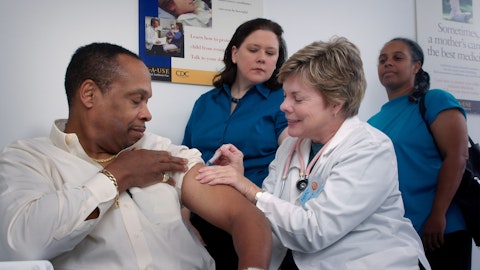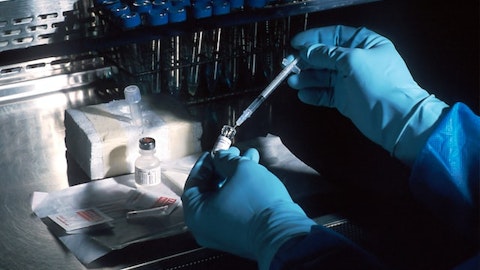AstraZeneca PLC (NASDAQ:AZN) Q2 2023 Earnings Call Transcript July 28, 2023
AstraZeneca PLC misses on earnings expectations. Reported EPS is $0.86 EPS, expectations were $0.98.
Operator: Good morning to those joining from the UK and the US. Good afternoon to those in Central Europe, and good evening to those listening in Asia. Welcome, ladies and gentlemen, to AstraZeneca’s Half Year and Q2 Results 2023 Webinar for investors and analysts. Before I hand over to AstraZeneca, I’d like to read the safe harbor statement. The company intends to utilize the safe harbor provisions of the United States Private Securities Litigation Reform Act of 1995. Participants on this call may make forward-looking statements with respect to the operations and financial performance of AstraZeneca. Although, we believe our expectations are based on reasonable assumptions, by their very nature, forward-looking statements involve risks and uncertainties and may be influenced by factors that could cause actual results to differ materially from those expressed or implied by these forward-looking statements.
Any forward-looking statements made on this call reflect the knowledge and information available at the time of this call. The company undertakes no obligation to update forward-looking statements. Please also carefully review the forward-looking statements disclaimer in the slide deck that accompanies this presentation and webinar. There will be an opportunity to ask questions after today’s presentation. Please use the raise your hand feature to indicate your wish to ask a question, and please remember to unmute your line when invited to speak. And with that, I’ll now hand you over to the company.
Andy Barnett: Thank you, operator, and welcome, everybody. I’m Andy Barnett, Head of Investor Relations at AstraZeneca, and I’m very pleased to welcome you to AstraZeneca’s first half and second quarter 2023 conference call. As usual, all materials presented are on our website. This slide contains our usual safe harbor statement. We will be making comments on our performance using constant exchange rates, or CER, core financial numbers and other non-GAAP measures. And non-GAAP to GAAP reconciliation is contained within the results announcement, numbers used are millions of US dollars unless otherwise stated. This slide shows our agenda for today’s call. Following our prepared remarks, we will open the line for questions. We will try and address as many questions as we can during the long time, although I’d asked the participants to limit the number of questions you ask to allow others a fair chance to participate in the Q&A.
As a reminder, to ask a question, please use the raise a hand function in Zoom or alternatively, you can click the Q&A button then write your questions. With that, Pascal, I will hand the call over to you.
Pascal Soriot: Thank you. Hello, everyone, and welcome. Please move on to the next slide. Total revenue in the first half of the year increased 4% to $22.3 billion, with 16% growth in our non-core medicines, offsetting a $2.2 billion decline in our COVID-19 medicines revenue. Core earnings per share increased 21% to $4.04. This increase reflects both our robust business performance, as well as a gain following an update to our contractor relationships for before in the US. We continue to benefit from our diverse commercial portfolio and our global footprint. Given our strong execution in the first half, we remain confident in our outlook for the remainder of the year, and we have reiterated our 2023 guidance. Next slide, please.
Taking a closer look at the performance of our non-COVID business across our regions in these areas, growth in the emerging markets continue to be strong. In particular, outside of China, emerging markets outside of China collectively grew by 38% in the first half. This growth underscores our confidence that these markets will become increasingly important to our business. We also saw double-digit growth across the EU and Europe in the period. On the right-hand side, you will see that we delivered a robust double-digit growth across oncology, severe RNI and rare disease. And as expected, we saw declines in B&I. This growth reflects strong medicines performance across these areas. Please advance to the next slide. When we look at performance across our portfolio in the first half, we had eight medicines deliver over $1 billion H1 product sales.
A broad range of these products are driving our growth, as you can see from this slide. For effective life cycle management, we’ve seen an acceleration in the rate of growth for several medicines, such as Imfinzi and Farxiga with new indications making important contributions to revenues. Ultomiris growth stood at, once again, and is the result of both successful conversion from Soliris as well as growth in patient numbers. We’ve also seen promising global growth from some of our more recently launched medicines including an HER2, Calquence, Breast03, Troponin and Saphnelo, all of which are helping to change the course of their respective diseases. Next slide, please. Confidence in our long-term outlook is supported by our robust let stage pipeline, which now has well over 120 active projects.
Importantly, we maintain a rigorous approach to R&D development. Setting a high bar for late-stage trial initiations and advancing only the most promising projects. We strive to stay at the front of the innovation curve and we have already progressed 14 new molecular entities into lettuce development. We’re making good progress towards initiating 30 new pivotal trials this year, having those nine in the year-to-date with recent additions, including the lithos trial for Breast03 asthma and two next-generation propane trials, which will support the expansion of our PMDI portfolio. As we indicated last quarter, most of the new pivotal trials are expected to dose in the second half of this year. Our pipeline continues to make exciting progress with eight positive pivotal oncology trials already this year.
These are shown on the right-hand side of this slide. In particular, we are encouraged by the positive results from the TROPION-Lung01 trial of Dato-DXd and are excited to unlock the full potential of this promising medicine. On the next slide, Aradhana can take you through our financial highlights in the first half as well as provide some further insights into how we are embracing the power of artificial intelligence across our manufacturing and supply chain. Over to you, Aradhana.
Aradhana Sarin: Thank you, Pascal, and good afternoon, everyone. As usual, I’ll start with our reported P&L. Please advance to the next slide. As Pascal mentioned, total revenue increased by 4% to $2.3 billion in the first half. Total revenue, excluding COVID-19 medicines, increased 16%. Alliance revenue of $627 million includes $475 million of an HER2 profit sharing from geographies where Daiichi Sankyo books product sales. Collaboration revenue of $220 million includes $180 million license fee from Serum Institute of India booked in the second quarter relating to our COVD-19 and anti-body license agreement. Please advance to the next slide, which shows our core P&L. The core product sales gross margin in the first half was 82.9%, benefiting from lower production costs in prior quarters, and certain non-recurring items in the first quarter.
As previously communicated, we expect the product sales gross margin in the second half to be negatively impacted, similar to in prior years, by seasonality for Flumis and certain other medicines, the mandatory price reduction for Tagrisso in Japan, as well as the full impact of inflation. We still expect the product sales gross margin on a full year basis to be slightly higher than pre-COVID-19 levels. Looking ahead beyond 2023, we expect product sales gross margin percentage will be negatively impacted by profit sharing arrangements. While we already see this dynamic with Lynparza, we anticipate the impact to increase as we start seeing higher sales from medicines such as HER2 and Tezspire in regions where we book product sales and then pay out a portion of profits to our partners through cost of sales.
Over the long-term, we’re focusing on driving productivity improvements to counter the impact on our gross margin from inflation, continued growth in emerging markets and more complex and expensive manufacturing of new modalities we’re investing in. Core operating expenses in the half increased by 8%, R&D costs increased by 9%, driven by continued investments in our pipeline. The increase in SG&A costs partly reflects spend behind new launches such as TOPAZ and HIMALAYA, which are driving the strong growth of Imfinzi and DUO, for example, as well as existing brands like Farxiga and Breast03 and geographic expansion of the rare disease medicines portfolio. We previously guided for total core operating expenses to increase by low to mid-single-digit percentage in 2023, and we now expect to finish the year towards the upper end of this range.
Similar to the phasing we observed in 2022, we expect R&D and SG&A spend to be weighted towards the second half. Other operating income of $1.1 billion includes $712 million related to the previously announced updated agreements on the Beyfortus, which was booked in the second quarter. The increase in other operating income is in line with the guidance set out at the start of the year where we said that other operating income would be higher versus last year. The tax rate in the second quarter was lower than full year guidance due to certain tax incentives and mix of profits and lower tax legal entities. For the full year, we continue to expect this core tax rate will be between 8% and 22%. Core EPS of $4.07 in the first half, represents an increase of 21% at constant exchange rates.
Next slide, please. Our net cash inflow from operating activities increased by $400 million to $4.9 billion, and we continue to see improvement in our cash conversion. Net debt increased by $1 billion to $24 billion, driven by the payment of the second interim dividend in March and $2.4 billion in deal payments, which include the second payment to Acerta made in the first quarter. As a reminder, we will pay the third and final payment in 2024. For the full year, we continue to anticipate deal payments related to prior business transactions to be in line with last year, around $2 billion, excluding Acerta. We have paid just under $1 billion in the first half. Our net debt-to-EBITDA ratio continues to decrease and is now at 1.9 times or 1.7 times, if excluding the non-cash adjustment for the Alexion inventory fair value uplift, which will soon disappear as we have now minimal inventory remaining from the time of the acquisition.
Today, we are reiterating our 2023 total revenue and core EPS guidance. Total revenues are expected to increase by low to mid-single-digit percentage. Excluding COVID-19 total revenue are expected to increase by low double-digit percentage. Growth in the second half will be hampered by patented expiries, including SynCor in the U.S. and Nexium in Japan, where we saw first generics end of last year. We now anticipate revenue in China to increase by a low to mid-single-digit percentage. And as I mentioned earlier, we now anticipate total operating expenses on the our end of the range, with phasing of SG&A costs towards the second half of the year, similar to prior years. In addition, given that we anticipate starting several new Phase 3 trials in the second half of the year, R&D and associated clinical and new product costs will be higher in the second half.

Copyright: dolgachov / 123RF Stock Photo
Based on June average FX rates, we now anticipate a low single-digit adverse FX impact on total revenue and a low to mid-single-digit adverse impact on core EPS. Please advance to the next slide. Continuing with the artificial intelligence team, today, I want to highlight global operations and how we are leveraging AI to accelerate drug development manufacturing processes and drive supply chain efficiencies. To share three specific examples here. First, in drug development, with our in-house AI-enabled tool, loop manager, we have reduced in route synthesis lead times from 9 to 12 months to five to six months, and we’re striving to further reduce lead times to less than three months. Additionally, with this tool, we have been able to reduce the number of experimental trials cutting lead times and driving efficiencies in case while also providing sustainability benefits through fewer synthetic steps.
Next, with AI-powered visualization of data, our operators are able to improve process performance for synthetic and biologic medicine by identifying critical variables that will affect yields and make real-time optimization adjustments. In the future, advanced continuous process verification will drive further robustness and yield increases. Third example, we’ve implemented AI-enabled enhancements across our supply chain. For example, Sweden is one of our largest global sites, manufacturing over 12 billion tablets and capsules every year. Here, we use AI-powered digital twins that can leverage multiple data sources simultaneously, such as production orders, dispensing stations and cleaning status to optimize production schedules. This technology has already delivered a 90% improvement in scheduling time, meaning we can now develop a dispensing plan in only four to five [ph] minutes worth used to take eight hours.
Our ambition is to leverage many of these tools and roll them throughout our manufacturing and supply network. This is, of course, a journey, but the work is already underway to use technology to drive efficiencies. While our operations team continues to deliver on seamless supply and new product launch delivery. With that, please advance to the next slide, and I will hand over to Dave to walk through our oncology business performance.
David Fredrickson: Thank you, Aradhana. Next slide, please. We’re pleased to report our oncology medicines delivered total revenues in the first half of $8.8 billion, an increase of 22% versus the prior year. We delivered double-digit product sales growth across all regions. Turning to individual medicine performance in the second quarter, Tagrisso Global revenues grew 10%, reflecting strong underlying demand for Dora and Flora across all regions. As expected, effective this June, we realized a mandatory price reduction in Japan. And in China, second quarter revenues reflect the first full quarter of — renewal pricing following reenlistment this March. Following the ASCO plenary presentation of Adora overall survival data last month, we expect expanded use of Tagrisso in the adjuvant setting as well as potential for new reimbursements in certain geographies.
Lastly, as we consider the future impact from IRA, our current interpretation of CMS final guidance supports the potential exclusion for Tagrisso under orphan drug protections. Lynparza remains the leading PARP inhibitor globally and delivered — sales growth of 9%. In the US, we saw sequential demand decline across the PARP inhibitor class following competitor label restrictions in second-line ovarian cancer. We continue to work on opportunities for US demand expansion in ovarian and HR-positive breast cancer, but still expect this to be more challenging. Outside of the US, we saw double-digit product sales growth across the EU, established rest of world, and emerging markets. In Q2, Imfinzi total revenues, inclusive of Imjudo, surpassed $1 billion in a quarter for the first time, up 58% and largely driven by new launches of TOPAZ, HIMALAYA, and POSEIDON.
I’ll touch on specific Imfinzi growth drivers a bit later, but needless to say, we’re excited by what the team has accomplished within a competitive I-O class. Calquence total revenues increased 34% year-on-year, supported by ex-US demand growth, particularly in Europe. And in the US, Calquence continues to maintain leadership in frontline CLL with the majority of new patient starts in this setting. However, we continue to see some new patient share loss in the relapsed/refractory segment. In HER2 total revenues of $322 million in the second quarter increased 176% year-on-year. In the US in HER2 new patient share in the HER2 positive metastatic breast cancer setting remains at a — and in the hormone receptor positive HER2 low post chemo-metastatic breast cancer share has now grown to above 50%.
Importantly, we’re seeing strong continued demand across the globe, particularly in European markets. Following the exciting approval for DESTINY-Breast03 in China last quarter, we received approval for HER2 in HER2 low metastatic breast cancer. Also during the period, we received approval for PROPEL in the US and anticipate a potential regulatory milestone to be paid in the second half of the year. And finally, we were granted priority review in the US for Capitala 291. Next slide, please. We’ve seen remarkable Imfinzi and Imjudo growth, driven by the recent launches of TOPAZ, HIMALAYA, and POSEIDON. We’re excited about the current trajectory of these launches and the broader potential of Imfinzi as supported by the suite of ongoing life cycle management programs.
First, HIMALAYA and unresectable hepatocellular carcinoma has established a clear foothold for Imfinzi in GI cancers. Last month at ESMO World GI, we presented unprecedented four-year overall survival data, the longest follow-up to-date in unresectable HCC. This sustained benefit, coupled with strong safety will continue to support rapid adoption and the establishment of a new standard-of-care. The launch of TOPAZ represents a step change innovation in biliary tract cancer and the strength of this data demonstrates the transformative benefit of IO in this setting. In the US, TOPAZ has become the undisputed standard-of-care within months. and the EU and Japan much are already outpacing the US trajectory. We’re making progress with POSEIDON in the US and in Europe with a crowded and competitive setting.
This launch together with our efforts with Pacific and Caspian continue to solidify a strong leadership position within lung cancer. In the first half of this year, we delivered four positive Phase III trials of novel Imfinzi combinations across lung, GI and GYN settings. MATTERHORN and gastric and gastroesophageal junction cancer was the first global Phase III and trial of IO plus flat that demonstrates statistically significant pathologic complete response. In endometrial cancer, we are excited to report that DOE showed Imfinzi + Lynparza and Imfinzi alone significantly improved progression-free survival, and Susan will cover these trials in more detail shortly. Over the balance of the year, we look forward to additional Phase III readouts with PACIFIC-2 in lung cancer and EMERALD-1 in GI.
Building on HIMALAYA, EMERALD-1 and EMERALD-2 will enable our leadership in HCC. Finally, we’ll continue to advance our next wave of IO with our novel bispecifics, volrustomig and rivagustimig and sabestomig. With that, please advance to the next slide, and I’ll hand over to Susan to cover key R&D highlights in the quarter.
See also 6 Cheap Solid State Battery Stocks to Buy and 10 Stock Market Forecasts Next 6 Months.
Q&A Session
Follow Astrazeneca Plc (NYSE:AZN)
Follow Astrazeneca Plc (NYSE:AZN)
Susan Galbraith: Thank you, Dave. Next slide, please. It’s been an exciting first half of the year with eight positive pivotal trial readouts. We had a large presence at ASCO with more than 130 abstracts, featuring 22 approved and potential medicines, highlighting the momentum of our pipeline. ASCO highlights include the final overall survival data from the Tagrisso ADAURA trial, demonstrating unprecedented survival in early-stage EGFR mutated lung cancer, as well as the first data from the ADAURA trial, highlighting the potential of PARP inhibition plus immunotherapy in advanced ovarian cancer. Additionally, interim data from the DESTINY-Pantumor02 trial and in HER2 to be the first therapy to show broad activity across a range of HER2-expressing advanced solid tumors.
Since ASCO, updated data showed HER2 resulted in clinically meaningful progression-free survival and overall survival. And I’m pleased to share that our initial interactions with the FDA have been encouraging. As mentioned previously, we reported high-level results for eight pivotal trials this quarter. I’ll touch on three of those readouts now. First, FLAURA2 demonstrated a strong clinically meaningful improvement in progression-free survival for patients with EGFR-mutated non-small cell lung cancer. Considering the EGFR mutated lung cancer landscape as a whole, we believe Tagrisso monotherapy will remain standard of care in first line, but see the opportunity for FLAURA2 to become a valuable regimen for patients with higher tumor burden. We’re delighted that these data have been selected for a presidential plenary presentation at the World Conference on Lung Cancer in September.
DUO-E is the first Phase III trial of immunotherapy plus PARP inhibition to demonstrate clinical benefit in advanced endometrial cancer. More than 400,000 patients are diagnosed with endometrial cancer each year and in advanced disease, survival remains poor, with only one in five patients living beyond five years. In DUO-E, both Imfinzi + Lynparza and Imfinzi alone significantly improves pogression-free survival when added to chemotherapy with the greatest clinically meaningful benefit observed with the combination of Imfinzi and Lynparza as maintenance treatment. Finally, over one million patients are diagnosed with gastric cancer each year, 45% of whom are eligible for perioperative chemotherapy. An early read from MATTERHORN demonstrated a statistically significant and clinically meaningful improvement with Imfinzi + FLOT versus FLOT chemotherapy alone in the key secondary endpoint of pathologic complete response, which we hope to see translate into an improvement in event-free survival over time.
Please advance to the next slide. We recently announced waited high-level results from the first Phase III trial for Dato-DXd, the TROPION-Lung01 trial. This trial investigated Dato-DXd versus docetaxel in second or third-line non-small cell lung cancer and demonstrated a statistically significant improvement in progression-free survival and an early trend in overall survival. The adverse event profile of Dato-DXd was overall consistent with previous trials, including rates of all-grade ILD. Whilst there were some cases of Grade 5 ILD observed in the trial, we are confident in the positive benefit risk profile for Dato-DXd. These data reinforce our view that Dato-DXd will be an important potential medicine in multiple cancers, including lung cancer.
Initial interactions with the FDA have been encouraging, and we are proceeding to file TROPION-Lung01. In addition to TROPION-Lung01, we have three active Phase III trials in the frontline setting, investigating Dato-DXd in combination with immune checkpoint inhibitors, TROPION-Lung07-08 and AVANZAR. Outcomes in these settings remain poor, less than half of patients treated the initial IO for chemotherapy living past two years. Combination Dato-DXd plus IO has already demonstrated encouraging clinical efficacy in the TROPION-Lung02 trial with durable objective response rates of 50% for Dato-DXd plus pembrolizumab and 57% for the Dato-DXd plus pembrolizumab and platinum-based chemotherapy across first-line patients. We’ll have further data to support the combination of lung cancer from TROPION-Lung04, which is a late-breaking abstract at the World Conference on Lung Cancer.




